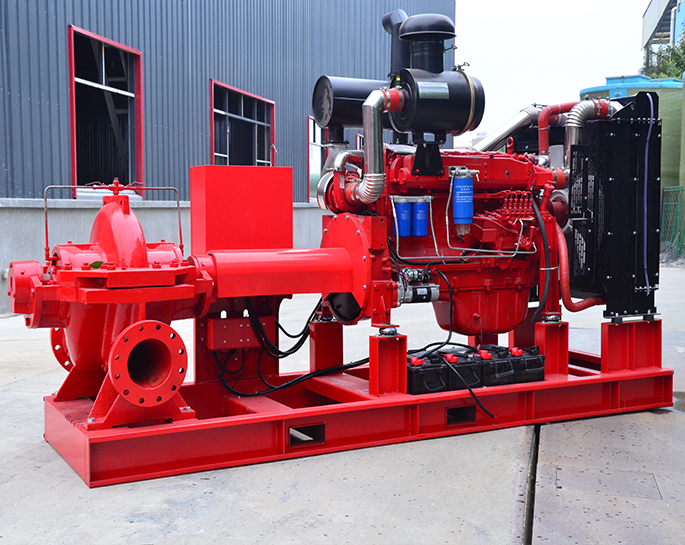Effective Maintenance Practices for Fire Pumps
Jun 19, 2023
Share:
Introduction:
Proper maintenance is crucial for the reliable performance of fire pumps, ensuring their readiness to respond to fire emergencies. Regular maintenance helps identify and address potential issues, enhances the longevity of the pump, and minimizes the risk of malfunctions. This essay explores key practices for maintaining fire pumps, emphasizing the importance of proactive maintenance to ensure optimal functionality.
Adherence to Manufacturer Guidelines:
One of the primary considerations in maintaining a fire pump is adhering to the manufacturer's guidelines. Manufacturers provide specific instructions for maintenance tasks, schedules, and recommended procedures. These guidelines outline essential steps to preserve the pump's performance, safety, and reliability. It is crucial to familiarize yourself with the manufacturer's recommendations and follow them diligently to avoid any potential damage or malfunction.
Regular Inspections:
Regular inspections are vital for identifying any signs of wear, damage, or deterioration. Inspect the fire pump, including electrical connections, control panels, gauges, valves, and piping systems. Look for leaks, corrosion, loose connections, or any other visible abnormalities. Additionally, inspect the suction and discharge lines, impeller, and seals for any signs of blockage or wear. Conduct inspections at recommended intervals and document any findings for future reference.
Lubrication and Cleaning:
Proper lubrication and cleaning are critical for maintaining the mechanical components of a fire pump. Lubricate moving parts as per the manufacturer's recommendations to reduce friction and prevent premature wear. Use approved lubricants and follow proper application techniques. Regularly clean the pump and its components to remove debris, sediment, or mineral deposits that may affect performance. Ensure strainers, impellers, and suction lines are free from obstruction, allowing for unimpeded water flow.
Testing and Exercising:
Regular testing and exercising of fire pumps are essential to verify their operational readiness. Conduct routine tests to evaluate water flow, pressure, and alarm systems. Test the pump at specified intervals or as recommended by the manufacturer. This ensures that the pump can generate the required water flow and pressure to effectively suppress fires. Exercising the pump periodically also helps prevent stagnation and ensures the smooth operation of its mechanical components.
Maintenance Documentation:
Maintaining detailed records and documentation is a crucial aspect of fire pump maintenance. Keep a comprehensive log that includes inspection dates, maintenance activities, test results, and any repairs or replacements performed. This documentation provides a historical record of maintenance actions and serves as a reference for future maintenance tasks. It aids in tracking the pump's performance, identifying recurring issues, and demonstrating compliance with regulatory requirements.
Conclusion:
Regular and proactive maintenance is vital for ensuring the reliable performance of fire pumps. Adhering to manufacturer guidelines, conducting regular inspections, lubricating and cleaning components, testing and exercising the pump, and maintaining detailed documentation are key practices to follow. By implementing these maintenance measures, fire safety professionals can maximize the longevity and effectiveness of fire pumps, ultimately enhancing fire protection measures and contributing to the safety of lives and property during fire emergencies.

Proper maintenance is crucial for the reliable performance of fire pumps, ensuring their readiness to respond to fire emergencies. Regular maintenance helps identify and address potential issues, enhances the longevity of the pump, and minimizes the risk of malfunctions. This essay explores key practices for maintaining fire pumps, emphasizing the importance of proactive maintenance to ensure optimal functionality.
Adherence to Manufacturer Guidelines:
One of the primary considerations in maintaining a fire pump is adhering to the manufacturer's guidelines. Manufacturers provide specific instructions for maintenance tasks, schedules, and recommended procedures. These guidelines outline essential steps to preserve the pump's performance, safety, and reliability. It is crucial to familiarize yourself with the manufacturer's recommendations and follow them diligently to avoid any potential damage or malfunction.
Regular Inspections:
Regular inspections are vital for identifying any signs of wear, damage, or deterioration. Inspect the fire pump, including electrical connections, control panels, gauges, valves, and piping systems. Look for leaks, corrosion, loose connections, or any other visible abnormalities. Additionally, inspect the suction and discharge lines, impeller, and seals for any signs of blockage or wear. Conduct inspections at recommended intervals and document any findings for future reference.
Lubrication and Cleaning:
Proper lubrication and cleaning are critical for maintaining the mechanical components of a fire pump. Lubricate moving parts as per the manufacturer's recommendations to reduce friction and prevent premature wear. Use approved lubricants and follow proper application techniques. Regularly clean the pump and its components to remove debris, sediment, or mineral deposits that may affect performance. Ensure strainers, impellers, and suction lines are free from obstruction, allowing for unimpeded water flow.
Testing and Exercising:
Regular testing and exercising of fire pumps are essential to verify their operational readiness. Conduct routine tests to evaluate water flow, pressure, and alarm systems. Test the pump at specified intervals or as recommended by the manufacturer. This ensures that the pump can generate the required water flow and pressure to effectively suppress fires. Exercising the pump periodically also helps prevent stagnation and ensures the smooth operation of its mechanical components.
Maintenance Documentation:
Maintaining detailed records and documentation is a crucial aspect of fire pump maintenance. Keep a comprehensive log that includes inspection dates, maintenance activities, test results, and any repairs or replacements performed. This documentation provides a historical record of maintenance actions and serves as a reference for future maintenance tasks. It aids in tracking the pump's performance, identifying recurring issues, and demonstrating compliance with regulatory requirements.
Conclusion:
Regular and proactive maintenance is vital for ensuring the reliable performance of fire pumps. Adhering to manufacturer guidelines, conducting regular inspections, lubricating and cleaning components, testing and exercising the pump, and maintaining detailed documentation are key practices to follow. By implementing these maintenance measures, fire safety professionals can maximize the longevity and effectiveness of fire pumps, ultimately enhancing fire protection measures and contributing to the safety of lives and property during fire emergencies.







